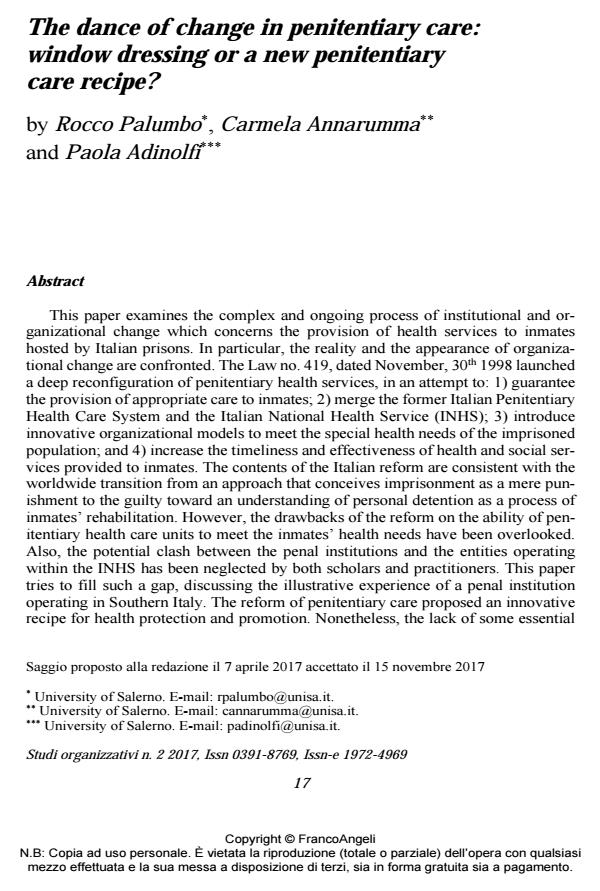The dance of change in penitentiary care: window dressing or a new penitentiary care recipe?
Titolo Rivista STUDI ORGANIZZATIVI
Autori/Curatori Rocco Palumbo, Carmela Annarumma, Paola Adinolfi
Anno di pubblicazione 2018 Fascicolo 2017/2
Lingua Inglese Numero pagine 27 P. 17-43 Dimensione file 258 KB
DOI 10.3280/SO2017-002002
Il DOI è il codice a barre della proprietà intellettuale: per saperne di più
clicca qui
Qui sotto puoi vedere in anteprima la prima pagina di questo articolo.
Se questo articolo ti interessa, lo puoi acquistare (e scaricare in formato pdf) seguendo le facili indicazioni per acquistare il download credit. Acquista Download Credits per scaricare questo Articolo in formato PDF

FrancoAngeli è membro della Publishers International Linking Association, Inc (PILA)associazione indipendente e non profit per facilitare (attraverso i servizi tecnologici implementati da CrossRef.org) l’accesso degli studiosi ai contenuti digitali nelle pubblicazioni professionali e scientifiche
This paper examines the complex and ongoing process of institutional and or-ganizational change which concerns the provision of health services to inmates hosted by Italian prisons. In particular, the reality and the appearance of organiza-tional change are confronted. The Law no. 419, dated November, 30th 1998 launched a deep reconfiguration of penitentiary health services, in an attempt to: 1) guarantee the provision of appropriate care to inmates; 2) merge the former Italian Penitentiary Health Care System and the Italian National Health Service (INHS); 3) introduce innovative organizational models to meet the special health needs of the imprisoned population; and 4) increase the timeliness and effectiveness of health and social services provided to inmates. The contents of the Italian reform are consistent with the worldwide transition from an approach that conceives imprisonment as a mere punishment to the guilty toward an understanding of personal detention as a process of inmates’ rehabilitation. However, the drawbacks of the reform on the ability of penitentiary health care units to meet the inmates’ health needs have been overlooked. Also, the potential clash between the penal institutions and the entities operating within the INHS has been neglected by both scholars and practitioners. This paper tries to fill such a gap, discussing the illustrative experience of a penal institution operating in Southern Italy. The reform of penitentiary care proposed an innovative recipe for health protection and promotion. Nonetheless, the lack of some essential ingredients of this recipe leads to question whether the organizational change of penitentiary care is real or it is merely apparent.
Il presente lavoro si propone di analizzare il complesso e tuttora in atto processo di cambiamento organizzativo e istituzionale che concerne i servizi di assistenza sanitaria negli istituti di pena italiani. La Legge 419 del 30 Novembre 1998 ha dato avvio a una profonda riorganizzazione della sanità penitenziaria, nel tentativo di: 1) garantire la prestazione di servizi di assistenza sanitaria appropriati; 2) includere il sistema sanitario penitenziario all'interno del Servizio Sanitario Nazionale; 3) introdurre modelli organizzativi innovativi, nell'intento di accrescere la capacità di soddisfazione dei bisogni di assistenza dei ristretti; e 4) accrescere l'efficacia e la tempestività dei servizi di assistenza erogati. I contenuti della riforma italiana sono in linea con la transizione - su scala globale - da una concettualizzazione retributiva della pena detentiva a un'interpretazione riabilitativa di quest'ultima. Tuttavia, il potenziale conflitto tra gli istituti di pena e gli attori che agiscono all’interno del Servizio Sanitario Nazionale è stato sottovalutato sia in letteratura che nella pratica professionale. Analogamente, le ripercussioni della riorganizzazione della sanità penitenziaria sulla capacità degli istituti di pena di soddisfare le particolari esigenze di salute dei detenuti è stata trascurata. L’articolo si propone di contribuire a colmare il gap nella letteratura scientifica, discutendo l’esperienza di un istituto di pena attivo nel Mezzogiorno italiano. La riforma della sanità penitenziaria in Italia ha ispirato la formulazione di una nuova ricetta per la tutela e la promozione della salute in carcere. D'altronde, alcuni ingredienti fondamentali per l'implementazione di siffatta ricetta non sono tuttora disponibili, impedendo la riorganizzazione dei servizi di sanità penitenziaria.
Parole chiave:Servizi di assistenza sanitaria; stato di salute dei ristretti; cambiamento organizzativo; isomorfismo.
- State of transition to Ministry of Health governance of prison healthcare in the Council of Europe region M.C. Van Hout, U.-B. Klankwarth, S. Fleißner, J. Pont, H. Stöver, in Public Health /2024 pp.151
DOI: 10.1016/j.puhe.2024.01.020
Rocco Palumbo, Carmela Annarumma, Paola Adinolfi, The dance of change in penitentiary care: window dressing or a new penitentiary care recipe? in "STUDI ORGANIZZATIVI " 2/2017, pp 17-43, DOI: 10.3280/SO2017-002002